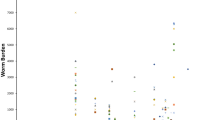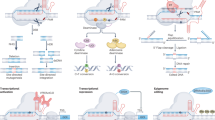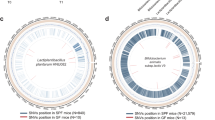Abstract
The inclusion of genetically modified (GM) plants in the human diet has raised concerns about the possible transfer of transgenes from GM plants to intestinal microflora and enterocytes. The persistence in the human gut of DNA from dietary GM plants is unknown. Here we study the survival of the transgene epsps from GM soya in the small intestine of human ileostomists (i.e., individuals in which the terminal ileum is resected and digesta are diverted from the body via a stoma to a colostomy bag). The amount of transgene that survived passage through the small bowel varied among individuals, with a maximum of 3.7% recovered at the stoma of one individual. The transgene did not survive passage through the intact gastrointestinal tract of human subjects fed GM soya. Three of seven ileostomists showed evidence of low-frequency gene transfer from GM soya to the microflora of the small bowel before their involvement in these experiments. As this low level of epsps in the intestinal microflora did not increase after consumption of the meal containing GM soya, we conclude that gene transfer did not occur during the feeding experiment.
This is a preview of subscription content, access via your institution
Access options
Subscribe to this journal
Receive 12 print issues and online access
$209.00 per year
only $17.42 per issue
Buy this article
- Purchase on Springer Link
- Instant access to full article PDF
Prices may be subject to local taxes which are calculated during checkout




Similar content being viewed by others
References
Gebhard, F. & Smalla, K. Transformation of Acinetobacter sp. strain BD413 by transgenic sugar beet DNA. Appl. Environ. Microbiol. 64, 1550–1554 (1998).
Einspanier, R. et al. The fate of forage plant DNA in farm animals: a collaborative case-study investigating cattle and chicken fed recombinant plant material. Eur. Food Res. Technol. 212, 129–134 (2001).
Schubbert, R., Lettmann, C. & Doerfler, W. Ingested foreign (phage M13) DNA survives transiently in the gastrointestinal tract and enters the bloodstream of mice. Mol. Gen. Genet. 242, 495–504 (1994).
Schubbert, R., Renz, D., Schmitz, B. & Doerfler, W. Foreign (M13) DNA ingested by mice reaches peripheral leukocytes, spleen, and liver via the intestinal wall mucosa and can be covalently linked to mouse DNA. Proc. Natl. Acad. Sci. USA 94, 961–966 (1997).
Schubbert, R., Hohlweg, U., Renz, D. & Doerfler, W. On the fate of orally ingested foreign DNA in mice: chromosomal association and placental transmission to the fetus. Mol. Gen. Genet. 259, 569–576 (1998).
Mercer, D.K., Scott, K.P., Bruce-Johnson, W.A., Glover, L.A. & Flint, H.J. Fate of free DNA and transformation of the oral bacterium Streptococcus gordonii DL1 by plasmid DNA in human saliva. Appl. Environ. Microbiol. 65, 6–10 (1999).
Duggan, P.S., Chambers, P.A., Heritage, J. & Forbes, J.M. Survival of free DNA encoding antibiotic resistance from transgenic maize and the transformation activity of DNA in ovine saliva, ovine rumen fluid and silage effluent. FEMS Microbiol. Letts. 191, 71–77 (2000).
Netherwood, T. et al. Gene transfer in the gastrointestinal tract. Appl. Environ. Microbiol. 65, 5139–5141 (1999).
Chambers, P.A., Duggan, P.S., Heritage, J. & Forbes, J.M. The fate of antibiotic resistance marker genes in transgenic plant feed material fed to chickens. J. Antimicrob. Chemother. 49, 161–164 (2002).
Martín-Orúe, S.M. et al. Degradation of transgenic DNA from genetically modified soya and maize in human intestinal simulations. Br. J. Nutr. 87, 533–542 (2002).
Vodkin, L.O., Rhodes, P.R. & Goldberg, R.B. cA lectin gene insertion has the structural features of a transposable element. Cell 34, 1023–1031 (1983).
Meyer, R., Chardonnens, F., Hubner, P. & Luthy, J. Polymerase chain reaction (PCR) in the quality and safety assurance of food: detection of soya in processed meat products. Z. Lebensm. Unters. Forsch. 203, 339–344 (1996).
Studer, E., Rhyner, C., Lüthy, J. & Hübner, P. Quantitative competitive PCR for the detection of genetically modified soybean and maize. Z. Lebensm. Unters. Forsch. 207, 207–213 (1998).
Adlerberth, I. et al. A mannose-specific adherence mechanism in Lactobacillus plantarum conferring binding to the human colonic cell line HT-29. Appl. Environ. Microbiol. 62, 2244–2251 (1996).
Hoiseth, S.K. & Stocker, B.A.D. Aromatic dependent Salmonella typhimurium are non-virulent and effective as live vaccines. Nature 291, 238–239 (1981).
Hidalgo, I.J., Raub, T.J. & Borchardt, R.T. Characterization of the human colon carcinoma cell line (Caco-2) as a model system for intestinal epithelial permeability. Gastroenterology 96, 736–749 (1989).
Andersson, H. The ileostomy model for the study of carbohydrate digestion and carbohydrate effects on sterol excretion in man. Eur. J. Clin. Nutr. 46, S69–76 (1992).
Langkilde, A.M., Champ, M. & Andersson, H. Effects of high-resistant-starch banana flour (RS(2)) on in vitro fermentation and the small-bowel excretion of energy, nutrients, and sterols: an ileostomy study. Am. J. Clin. Nutr. 75, 104–111 (2002).
Normen, L., Laerke, H.N., Jensen, B.B., Langkilde, A.M. & Andersson, H. Small-bowel absorption of D-tagatose and related effects on carbohydrate digestibility: an ileostomy study. Am. J. Clin. Nutr. 73, 105–110 (2001).
Ruiz, T.R., Andrews, S. & Smith, G.B. Identification and characterization of nuclease activities in anaerobic environmental samples. Can. J. Microbiol. 46, 736–740 (2000).
McCartney, A.L. Application of molecular biological methods for studying probiotics and the gut flora. Br. J. Nutr. 88, S29–37 (2002).
Stach, J.E. & Burns, R.G. Enrichment versus biofilm culture: a functional and phylogenetic comparison of polycyclic aromatic hydrocarbon-degrading microbial communities. Environ. Microbiol. 4, 169–182 (2002).
Caldwell, D.E., Wolfaardt, G.M., Korber, D.R. & Lawrence, J.R. in Manual of Environmental Microbiology (eds. Hurst, J.H., Knudsen, G.R., McInerney, L.D., Stetzenbach, M.J. & Walter, W.V.) 79–90 (American Society for Microbiology Press, Washington, DC, 1997).
Yamo, T. et al. Abnormal expression of CD44 variants on the exfoliated cells in the faeces of patients with colorectal cancer. Gastroenterology 114, 1196–1205 (1998).
Kerovuo, J. & Tynkkynen, S. Expression of Bacillus subtilis phytase in Lactobacillus plantarum 755. Lett. Appl. Microbiol. 30, 325–329 (2000).
Soole, K.L. et al. Constitutive secretion of a bacterial enzyme by polarized epithelial cells. J. Cell Sci. 102, 495–504 (1992).
Silley, P. & Armstrong, D.G. Changes in metabolism of the rumen bacterium Streptococcus bovis H13/1 resulting from alteration in dilution rate and glucose supply per unit time. J. Appl. Bacteriol. 57, 345–353 (1984).
Warner, A.C.I. Nutr. Abstr. Rev. B51, 789–820 (1981).
Malawer, S.J. & Powell, D.W. An imported turbidimetric analysis of polyethylene glycol utilizing an emulsifier. Gastroenterology 53, 250–255 (1967).
Padgette, S.R. et al. Development, identification and characterization of a glyphosate-tolerant soybean line. Crop Sci. 35, 1451–1461 (1995).
Acknowledgements
We would like to thank the Food Standards Agency for supporting this work and we also thank Jay Varma for recruiting the ileostomists.
Author information
Authors and Affiliations
Corresponding author
Ethics declarations
Competing interests
The authors declare no competing financial interests.
Rights and permissions
About this article
Cite this article
Netherwood, T., Martín-Orúe, S., O'Donnell, A. et al. Assessing the survival of transgenic plant DNA in the human gastrointestinal tract. Nat Biotechnol 22, 204–209 (2004). https://doi.org/10.1038/nbt934
Received:
Accepted:
Published:
Issue Date:
DOI: https://doi.org/10.1038/nbt934
This article is cited by
-
Horizontal transfer of antibiotic resistance genes into microflora and blood cells in rats fed on GM-diet
Bulletin of the National Research Centre (2022)
-
Artificial Meat Industry: Production Methodology, Challenges, and Future
JOM (2022)
-
Genetically engineered (modified) crops (Bacillus thuringiensis crops) and the world controversy on their safety
Egyptian Journal of Biological Pest Control (2018)
-
Fecal Recovery of Ingested Cellular DNA: Implications for Noninvasive Detection of Upper Gastrointestinal Neoplasms
Digestive Diseases and Sciences (2016)



